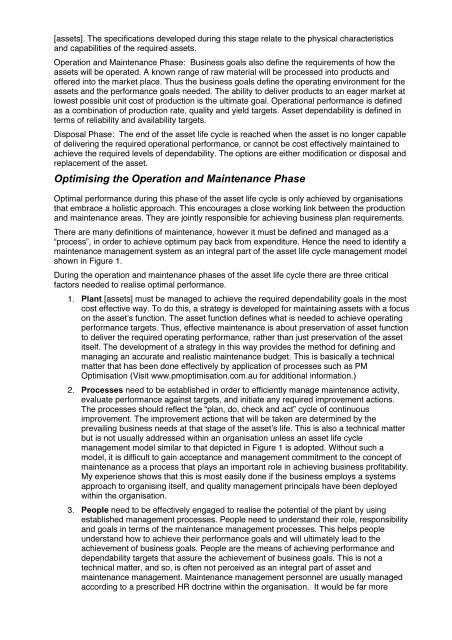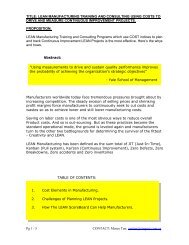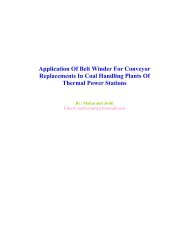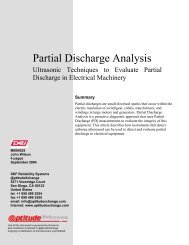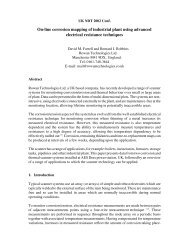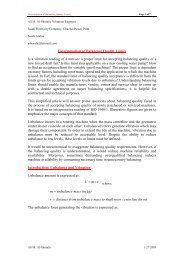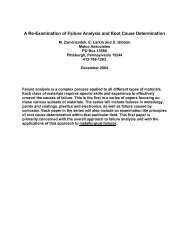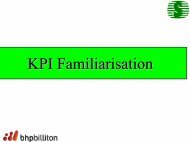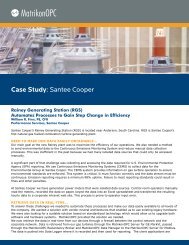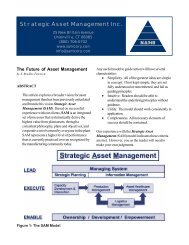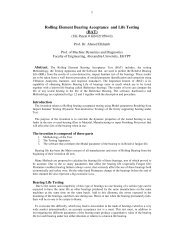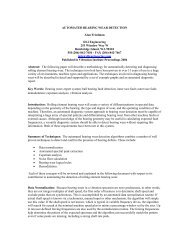Asset Management - Plant Maintenance Resource Center
Asset Management - Plant Maintenance Resource Center
Asset Management - Plant Maintenance Resource Center
You also want an ePaper? Increase the reach of your titles
YUMPU automatically turns print PDFs into web optimized ePapers that Google loves.
[assets]. The specifications developed during this stage relate to the physical characteristics<br />
and capabilities of the required assets.<br />
Operation and <strong>Maintenance</strong> Phase: Business goals also define the requirements of how the<br />
assets will be operated. A known range of raw material will be processed into products and<br />
offered into the market place. Thus the business goals define the operating environment for the<br />
assets and the performance goals needed. The ability to deliver products to an eager market at<br />
lowest possible unit cost of production is the ultimate goal. Operational performance is defined<br />
as a combination of production rate, quality and yield targets. <strong>Asset</strong> dependability is defined in<br />
terms of reliability and availability targets.<br />
Disposal Phase: The end of the asset life cycle is reached when the asset is no longer capable<br />
of delivering the required operational performance, or cannot be cost effectively maintained to<br />
achieve the required levels of dependability. The options are either modification or disposal and<br />
replacement of the asset.<br />
Optimising the Operation and <strong>Maintenance</strong> Phase<br />
Optimal performance during this phase of the asset life cycle is only achieved by organisations<br />
that embrace a holistic approach. This encourages a close working link between the production<br />
and maintenance areas. They are jointly responsible for achieving business plan requirements.<br />
There are many definitions of maintenance, however it must be defined and managed as a<br />
“process”, in order to achieve optimum pay back from expenditure. Hence the need to identify a<br />
maintenance management system as an integral part of the asset life cycle management model<br />
shown in Figure 1.<br />
During the operation and maintenance phases of the asset life cycle there are three critical<br />
factors needed to realise optimal performance.<br />
1. <strong>Plant</strong> [assets] must be managed to achieve the required dependability goals in the most<br />
cost effective way. To do this, a strategy is developed for maintaining assets with a focus<br />
on the asset’s function. The asset function defines what is needed to achieve operating<br />
performance targets. Thus, effective maintenance is about preservation of asset function<br />
to deliver the required operating performance, rather than just preservation of the asset<br />
itself. The development of a strategy in this way provides the method for defining and<br />
managing an accurate and realistic maintenance budget. This is basically a technical<br />
matter that has been done effectively by application of processes such as PM<br />
Optimisation (Visit www.pmoptimisation.com.au for additional information.)<br />
2. Processes need to be established in order to efficiently manage maintenance activity,<br />
evaluate performance against targets, and initiate any required improvement actions.<br />
The processes should reflect the “plan, do, check and act” cycle of continuous<br />
improvement. The improvement actions that will be taken are determined by the<br />
prevailing business needs at that stage of the asset’s life. This is also a technical matter<br />
but is not usually addressed within an organisation unless an asset life cycle<br />
management model similar to that depicted in Figure 1 is adopted. Without such a<br />
model, it is difficult to gain acceptance and management commitment to the concept of<br />
maintenance as a process that plays an important role in achieving business profitability.<br />
My experience shows that this is most easily done if the business employs a systems<br />
approach to organising itself, and quality management principals have been deployed<br />
within the organisation.<br />
3. People need to be effectively engaged to realise the potential of the plant by using<br />
established management processes. People need to understand their role, responsibility<br />
and goals in terms of the maintenance management processes. This helps people<br />
understand how to achieve their performance goals and will ultimately lead to the<br />
achievement of business goals. People are the means of achieving performance and<br />
dependability targets that assure the achievement of business goals. This is not a<br />
technical matter, and so, is often not perceived as an integral part of asset and<br />
maintenance management. <strong>Maintenance</strong> management personnel are usually managed<br />
according to a prescribed HR doctrine within the organisation. It would be far more


